 Intel’s drawn out drip feed of Alder Lake details ends today with a whimper not a bang. SemiAccurate was fed up with the Intel BS earlier and things have gone down hill since then.
Intel’s drawn out drip feed of Alder Lake details ends today with a whimper not a bang. SemiAccurate was fed up with the Intel BS earlier and things have gone down hill since then.
Lets start out by saying Intel’s big dog and pony show for Alder Lake and it’s big/little copy are nothing more than a distraction. SemiAccurate spent weeks trying to find some reason that the massive software complexity and hard tie in to Windows 11 was worth it. We failed. TLDR: There is no reason Alder Lake needs or should have a big/little clone. Really. If you bother to read the rest of this article you will see our reasons for this but, well, not much else to see here other than the SKUs and prices.
Then there is the simple fact that Intel repeatedly lied to SemiAccurate and others. Normally we don’t use the word lie, we point out that there is often a shred of something that can be used for plausible deniability. This time Intel flat out lied to us and the rest of the journalists. To make things worse the front line PR folk who interface with us usually get the blame and when we call the miscreants high above their head on the unethical behavior. If you are high enough up, it never is your fault if you have minions to deflect things at. So apologies to the front line folk but the people above you absolutely did wrong.
What did they lie about? Go back to our Architecture Day story and see if you can figure out the tone of the story. You might notice a little frustration and annoyance amid the joyous lack of any useful information. Any attempt to glean useful technical information that should have been provided without asking was met with one of two responses, “That is a product question that we can’t answer yet”, and, “That will be revealed closer to launch”.
The former was the minority of responses and actually fair if annoying. The latter was inexcusable given our obviously mistaken notion that Architecture Day should have, well you know, architecture. It was also a direct lie. Why? Because it is the launch and Intel did not and will not give us those details, they didn’t even try. It isn’t a bending of the truth, it is a lie and unfortunately those responsible will bear not consequences, that is the Intel way. It is also why the company is rotting from the inside out. That said we still don’t like being lied to.
Back to the ‘launch’ of Alder Lake, we use the quotes because the reviews are not allowed to be published until a later date, a classic sign that a company wants the hype to echo before the cold water of truth is poured on the products. Not only is this unethical but it is also very annoying. At least it isn’t a lie though so silver lining?
So what is being launched today? Six desktop SKUs that Intel is calling 12th Gen although that generational term has lost all meaning many years ago. They range from 6+4 to 8+8 cores but Intel would prefer it if you used threads because that makes them look less stupid. We won’t. In any case the lineup looks like this.
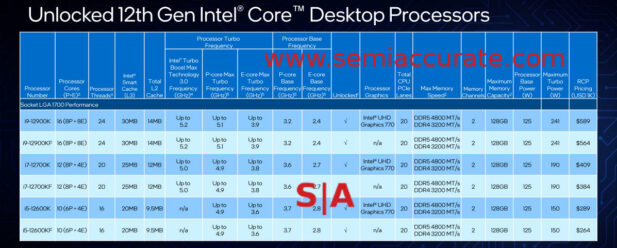
SKU chart
We would love to tell you about the dies, their sizes, transistor counts, and any technical details but other than it being on a 10+++/Superfin+/”7″ process and that the yields are still absymal, we can’t. Why? Intel flat out refuses to answer such questions because the main point of their company, process tech, is something that can no longer be promoted. If you are sensing this idiocy did and still does annoy SemiAccurate, you are right, their is simply no technical justification for this stonewalling. People should be fired for suggesting it but once again, this is the Intel way now.
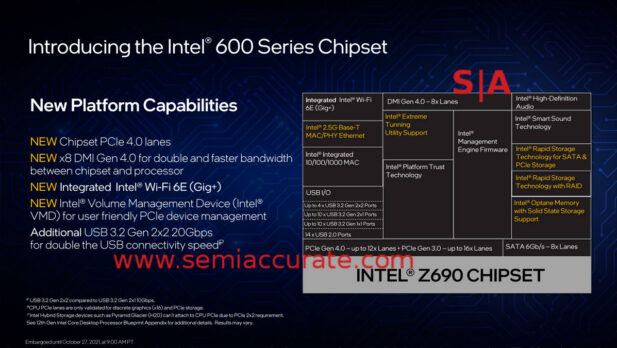
600 series chipset in ‘detail’
Intel disclosed a bit about the new 600-Series chipsets but as you can see above, nothing really new or exciting. 99% of it was disclosed weeks ago and the so called diagram is nothing more than marketing BS. Look, boxes with marketing terms and a few specs in them, yay! That said it appears to suggest some things that are flat out wrong like Xpoint on the chipset and the management firmware taking up more die area than the analog I/Os. Then again with the anti-technical bent from Intel of late, this is the least of their offenses.
On the up side there was one positive thing we can say, Intel did go a long way towards properly documenting their footnotes and claims. There were a few links that remain but for the most part Intel really did right here. AMD are you listening? Of course not, they simply don’t care to do right but it looks like Intel is trying again so well done.
The rest of the talk was a rehash of old claims with a few new number and bullet points fleshed out. Overclocking might have been interesting but the hard ties to Windows 11 make it useless to us but be aware there are few meager toys Intel threw out. Then again they fuse off those capabilities and charge you extra if you want to overclock so… well just buy a Ryzen CPU, they are better in every way and don’t extort you for overclocking and features.
Now to the meat of the ‘launch’, Intel’s copying of ARM’s big/little. When Intel launched their first phones, an executive who shall remain nameless said, “You only need to design a big and little core if you don’t know how to make one good one.” So it is confirmed that Intel’s architecture is following the path of their process development. OK low blow but they said it. Repeatedly. In public. Then again they were smarter than the server folk because they didn’t put it in print. More on this when Sapphire Rapids launches.
Anyway Intel copied big/little. Why? There is no technical justification, period. On a phone with a small battery, always on use cases, an OS that is instant wake, all powered by a small battery, milliWatts matter. On a laptop with a relatively huge battery where the blazing LEDs waste more energy than the delta between the lowest power state of a big and small core, there is no justification for it. Go look up how much energy the keyboard backlighting takes up, and the power and HDD LEDs. Shall I go on?
On a phone this delta might make a meaningful battery life difference over a day or two without a charge. On a laptop it may make the battery last a few minutes longer but you would likely be better off killing a few background tasks in Windows. The gains are meager if they exist at all in mobile. On a desktop with mains power, there is literally no excuse for copying ARM’s big/little, period.
The down side is the borderline crazy complexity on the software and hardware side. The whole Thread Director hardware block could have been interesting but Intel’s absolute refusal to discuss it’s architecture at, again, Architecture Day, plus them lying about revealing details closer to release, are a big red flag about it’s actual usefulness. Then it is hard tied to Windows 11, remember how well Microsoft does with schedulers? Since Qualcomm likely wrote most of this it may work for Intel but don’t count on it being supported or updated once the next shiny thing breaks cover. All this pain for what gain again?
If you ask Intel they will say that the four little cores take up the area of one big one and show you lots of benchmarks on the small cores. Then different benchmarks on the big cores when they need to show off single threaded prowess. For some odd reason they pick and choose benchmarks to show each set of cores off in a good light but never do they show or talk about what would happen with those four small cores replaced by two more big ones. Or if there are really no drawbacks and the small cores are really that efficient, wouldn’t 32 more of them instead of 8 big cores be the way to go? We asked. We didn’t get answers.
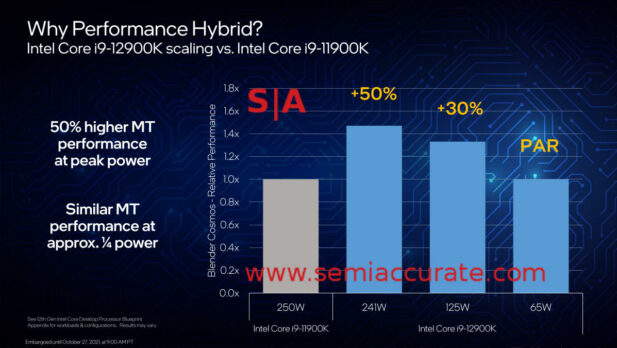
Looks good until you think about it
Alder Lake is amazingly efficient, just look at the graph above! Then consider that the graph, according to the appendix, is using SpecIntRate 2017, basically a measure of how well things thread and how many threads you have. Gosh, Alder has many more threads than Rocket Lake/i9-11900K, who knew? Then there is the fact that is it Rocket Lake, listed as 250W but Anandtech measured much more and SemiAccurate pointed out a few other little issues with the chip.
On top of this list is a 10nm design backported to 14nm which bloats the die size and inverts all the substantial power savings when going from 14nm to 10+/10++. Basically what you are seeing in the graph above is Intel picking the single best test to show threading and comparing Alder Lake to the single least efficient chip Intel released since the early P4 days. Any guess why they would do this instead of a fair comparison using relevant benchmarks? We are at a loss too. Giggle.
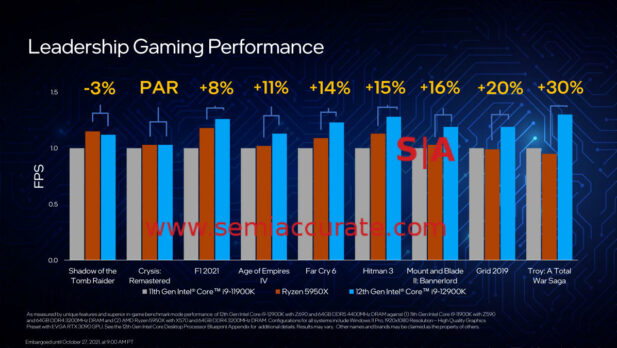
Gaming against a hobbled competitor
Then there is the gaming benchmarks. There is one, and only one, benchmark that compares Alder Lake against AMD products, the rest only compare against 14nm Intel products be they Rocket/Ice cores or Sky Lake derivatives. The AMD chips were crippled due to the Windows 11 cache and core selection bugs but to be fair Intel acknowledged that up front. This is the long way of saying the AMD numbers should increase substantially when the patches, now out, are applied.
That isn’t bad or underhanded though. What is a bit less ethical is the choice of the 16 core Ryzen 5950X as a comparison. Why is this bad? Well to start off with the i9-12900K is a $599 chip which is much more comparable to the 12C Ryzen 5900X at $549 than the bigger $749 5950X. More importantly the 12C 5900X is significantly faster at gaming than the 5950X, even AMD admits that. And Intel knows this because at CES 2020 they got a fair bit of flack for comparing against a 12C AMD product and they said they wanted to compare to the best AMD had at gaming. I guess the same people forgot that point when comparing to Alder Lake because… look over there, don’t think about such things. And the weather outside. And no independent benchmarks for a week or so longer. Any guesses why?
Then there are the content creation benchmarks, a place where more threads usually shine. This time they compare it to the AMD… nope, no AMD comparisons, only older 14nm Intel parts. Why? We won’t end this one with a leading question, we will just point out that the more better AMD cores will absolutely destroy the Intel CPU so no way that comparison would be posted before the hype train leaves the station. And don’t forget the BAPCO benchmarks, you know that ‘independent’ organization with a mailing address that was Intel HQ until it was changed to a P.O. Box. Need we go on?
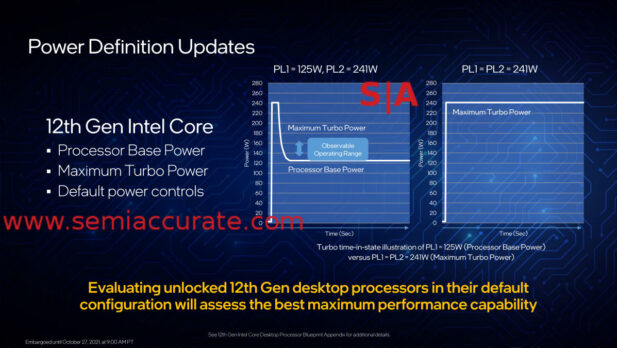
How to get a 241W CPU called 125W through legal
But it gets worse. Intel is no longer using TDP as you saw in the SKU table. What was TDP is now Processor Base Power, ostensibly 125W for the 12900K. Don’t forget that the faster AMD Ryzen 5900X/5950X are only 105W. Back to Intel they have sensibly set PL1=PL2=241W which acknowledges what the OEMs have been doing forever, jacking the power limites to the roof in the BIOS out of the box.
What this means is that the 125W figure is farcical, this is a 241W CPU and they are comparing to a 105W AMD CPU that may pull 50% more for short durations. Guess which number Intel talks about when describing the chip? Guess which one is closer to reality? Go back and look at those gaming benchmarks again and think about what they would look like if comparable energy was used. And Windows was fixed. And the right CPU was compared against.
Overall you have a CPU that really doesn’t win at anything compared against a year or so old AMD design but using some well chosen benchmarks and descriptions can be made to look like a killer part. It isn’t. When you add in the software complexity needed to make the whole design not be a huge step backward, there is absolutely no reason for this to exist on the desktop. On laptops you could make a case for meager battery life gains but those would be overwhelmingly outweighed by the added software complexity. Intel copying ARM’s big little is just stupid and should not have been done.
To reiterate the point, SemiAccurate spent weeks searching for something, anything, that would change our mind about big/little on Alder. We talked to software devs, game devs, and the like, and no one could give us anything to go on. Coupled with Intel dodging all the technical questions and lying to SemiAccurate, suffice it to say our initial fears were not dispelled. Add in Intel not releasing prices until well after the brief and NDAing independent numbers until after launch and you have a perfect storm. Given the ‘Intel Way’ this will be considered a resounding success but SemiAccurate feels the opposite is true.S|A
Charlie Demerjian
Latest posts by Charlie Demerjian (see all)
- Intel Announces their NXE: 5000 High NA EUV Tool - Apr 18, 2024
- AMD outs MI300 plans… sort of - Apr 11, 2024
- Qualcomm is planning a lot of Nuvia/X-Elite announcements - Mar 25, 2024
- Why is there an Altera FPGA on QTS Birch Stream boards? - Mar 12, 2024
- Doogee (Almost) makes the phone we always wanted - Mar 11, 2024